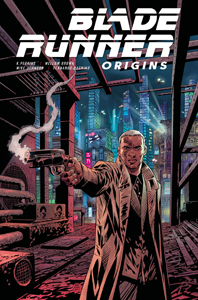In 2010, Boom Studios delivered a “Do Androids Dream of Electric Sheep” prequel (“Dust to Dust”), and in 2021, Titan Books launched its “Blade Runner” prequel series, “Origins.” As Philip K. Dick fans, we know the subtle differences between the book and the film, but those lines can easily get blurred when venturing further from the source material.
Replicant sentience
It comes down to what angle the writers want to take. Both projects examine the early days of identifying androids/replicants. In “Dust to Dust,” androids fail to show certain emotions recognizable in humans. It’s more theme-oriented, as befits a lead-in to Dick’s novel.
In “Origins” Issues 1-4 (Volume 1: “Products”), writers K. Perkins, Mellow Brown and Mike Johnson are more interested in adventure and mystery. It’s not about what causes replicants to stand out; only their rebellious actions and the fact that they’re (probably) listed in Tyrell’s records tell us they are replicants. The Voight-Kampff test hasn’t been invented at this point in the “BR” saga.

“Blade Runner: Origins” Issues 1-4 (2021)
Subtitle: “Volume 1: Products”
Writers: K. Perkins, Mellow Brown and Mike Johnson
Artist: Fernando Dagnino
Colorist: Marco Lesko
Unlike “Dust to Dust,” “Origins” is more about the simple fun of franchise continuity. We learn that the Nexus-5s, in 2009, are the first iteration of replicants to desire freedom and work toward it. (The “BR” film features Nexus-6s.)
This volume also introduces the first blade runner. But the trio of writers play coy. I think it’s safe to say the main character, the Los Angeles cop Moreaux, will become the first blade runner. At least, we’re led to believe it; but maybe we’re being set up for a twist.
And I think I picked out the murderous Nexus-5: Ilora Stahl, the woman who is ostensibly the liaison to the cops at the Tyrell Corporation. The V-K test isn’t available, but she shows signs of lacking empathy.
Reserving the revelations
Through four issues, though, the first blade runner and the first replicant aren’t openly identified to the reader. What’s more, Tyrell himself remains off-panel. The writers and artists keep these things up their sleeve.
But a slow unspooling of the plot is the “BR” aesthetic anyway. Artist Fernando Dagnino and colorist Marco Lesko (who returns from “BR: 2019” and “2029”) capture the look and vibe of this saga, although they foreground action and mystery over brooding thoughtfulness.
“Origins” is not as smooth as “2019”/ “2029.” That’s not because of a shortage of ideas, but arguably because of too many (although I admit there’s plenty of time to flesh these ideas out in future issues). For example, one character (a woman) is resurrected in a new replicant body (that of a man), and it’s confusing for a while.

Transplanting a mind into a new body is arguably a more advanced achievement than creating replicants, so that’s quite a revelation for a tangential plot. It fits broadly with PKD’s wild technological futures, although he wasn’t as interested in mind-body transference as in false humans.
Familiar … so far
“Products” ends with the revelation that the replicant underground has been formed. But I can’t tell from the art if the group’s leader is someone we already know or a new character. And I don’t know if we’re supposed to know, or if it’s simply a lead-in into the next volume, where we’ll get to know this person.
“Origins” slots into that category of “prequels that answer questions we never asked,” so people who hate those types of stories can skip it. It has little surprises – such as the trans-body character – but overall, it certainly doesn’t recontextualize “Blade Runner.”
Moreaux is a grizzled, disenchanted cop like Deckard and Ash. Stahl (if I’m right that she’s a replicant) is rebellious and a little psychopathic, like Roy Batty.
As the series goes forward, I’m looking forward to Tyrell’s appearance. The “2019”/ “2029” series intriguingly suggests he devised replicants not solely as products, but more importantly as a deliberate next phase of evolution. He intended that replicants would replace humans. I’ll be interested to see future volumes dig into that.

